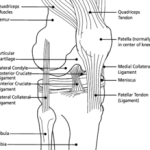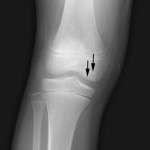LACKING APPROPRIATE RESEARCH SUPPORT OR THE NEXT GOLD STANDARD?
It must be the hottest debate in knee surgery at the moment. Should ACL reconstructions be performed using the LARS (Ligament Augmentation and Reconstruction System) or should orthopaedic surgeons continue to use the more traditional four strand hamstring (4HS) or bone patella tendon bone (BPTB) grafts? It is a good question. Obviously for us as sports physiotherapists the choice is not ours to make, but, invariably the injured athlete will ask our professional opinion.
So how do you reply when they say – “What do you think I should do?”. The easiest thing to do is give them some facts.
THE LARS SURGERY
The latest LARS is composed of polyethylene terephthalate – an industrial-strength polyester fibre. It can only be used in a population that has a well vascularised ACL stump, ideally in acute settings. The theory is that the LARS pulls the two ends of the ACL together and allow for fibroblastic ingrowth. Check out the video below for a sweet animation of the surgery – drilling tunnels, fixation etc.
OUTCOMES
The unfortunate thing about the ‘new’ LARS ligament is that there are no long-term follow-ups, as widespread use of the new ligaments has not been around. This is the biggest issue many orthopaedic specialists have, will it stand up to the test of time? You know what, only time will tell. Until then, the best research has approximately 5 year follow-ups. Therefore, the outcomes discussed below are within that time-frame.
DONOR SITE MORBIDITY
This is a benefit of the LARS graft option. Having no donor site means that there is no donor site morbidity. Roe et al. (2005) showed at 7 year follow up 14% of 4HS and 38% of BPTB patients had some donor site symptoms (tenderness, irritation or numbness). This is definitely a tick in the LARS box.
RTP TIME-FRAMES
Optimal management of a LARS reconstruction can result in RTP at the 3 month mark, which many would suggest is the main draw-card of the LARS. This is particularly given that it is widely accepted that appropriate RTP time-frames for 4HS and BPTB grafts are 6 – 12 months. The traditional graft choices mean that an ACL rupture is season ending whichever way you look at it. Another win for the LARS crew.
KNEE STABILITY
The studies widely examine knee stability utilising the KT1000, and a good level of stability is a side-to-side difference in anterior translation of less than 3mm. At four year follow-up, 73.9% of 4HS and 95.8% of LARS had less than 3mm of translation (Liu et al. 2010). Roe et al. (2005) showed that 82% of BPTB grafts had less than 3mm of translation at 5 year followup. This suggests that in the short term LARS offers increased knee stability.
ACTIVITY LEVELS
Generally measured using the Lysholm Knee Scale and Tegner Score. Liu et al. (2010) found no significant differences between LARS and 4HS grafts at 4 year follow up. Roe et al. (2005) found no significant differences between 4HS and BPTB at 5 and 7 year follow up.
COMPLICATION RATES
In the short term window i.e. 5 year follow up, there does not seem to be a major difference in failure rates. Gao et al (2010) showed a complication rate of approximately 6% at 5 years. Roe et al. (2005) suggests that there is no significant difference between BPTB and 4HS failure rates at 7 year followup – about 20% for both. Interestingly, the study found those with patellar tendon grafts were more likely to rupture their contralateral ACL (18%) than ipsilateral (4%), whilst for 4HS grafts there was approximately even risk (10%) between legs. Either way you can tell your athlete they have a one in five chance of ending up with another ACL rupture.
SUMMARY
Information overload? In summary, this evidence suggests at 4 year follow up the LARS show improved outcomes of:
- Donor Site Morbidity
- RTP Timeframes
- Knee Stability
CONCLUSIONS
You know what, I was surprised by these results. One thing has been made clear to me:
The LARS Ligament can be used as a short-term short-rehab solution for ACL ruptures.
Other than that, I could not in good conscience recommend the LARS ligament to athletes. If you are pushing for one more season, one more Olympic Games or one more contract signing in the short term then the LARS may be the appropriate decision. However, there is no long-term data to display what the longer term outcome is going to be.
If these new generation LARS ligaments do hold up to the test of time we could be looking at a new gold standard. Until then – I would take the Leo’s advice.
What are your thoughts or experiences with each graft choice? Agree, disagree, furious? Comment here, or catch me on Twitter or Facebook.
REFERENCES
Roe J, Pinczewski LA, Russell VJ, Salmon L, Kawamata T and Chew M. A 7-Year Follow-up of Patellar Tendon and Hamstring Tendon Grafts for Arthroscopic Anterior Cruciate Ligament Reconstruction : Differences and Similarities. Am J Sports Med 2005 33: 1337
Gao K, Chen S, Wang L, Zhang W, Kang Y, Dong Q, Zhou H, Li L. Anterior Cruciate Ligament Reconstruction With LARS Artificial Ligament: A Multicenter Study With 3- to 5-Year Follow-up.
Arthroscopy – Journal of Arthroscopic and Related Surgery (2010) 26 (4), pp. 515-523
Liu Z, Zhang X, Jiang Y, Zeng B. Four-strand hamstring tendon autograft versus LARS artificial ligament for anterior cruciate ligament reconstruction. International Orthopaedics (SICOT) (2010) 34:45–49
Related Posts
Comments
Trackbacks
-
[…] This post was mentioned on Twitter by The Sports PT, The Sports PT. The Sports PT said: ACL #orthopedic #surgery with LARS ligament: Lacking Appropriate Research Support or Gold Standard? http://bit.ly/bHUd4U #physiotherapy […]
-
… trackback …..
C’est un tr¨¨s int¨¦ressant publier , J’ai utilis¨¦ pour ¨ºtre recherchant cette info. Simplement si vous reconna?trez je situ¨¦ votre weblog site web apr¨¨s je a v¨¦rification des blogs comme le mien, donc veuillez essayez mon site quelque temps dou…










I had LARS knee reconstruction 17 months ago after a fall I was non weight bearing for about six weeks till my surgery and also had a small break to the top of my tibia I am now 48 yo still seeing my physio weekly or every ten days I have had two arthroscopys one about eleven weeks ago after a fall and one last year after my foot went down a hole in grass so I have had some setbacks but I’m not convinced. My knee is very rigid in the kneecap I am nearly there with straightening but am having alot of trouble with bending I have some pain in the back of my knee and did have a bakers cyst after original accident and then had a rupture after most recent fall and was in a lot of pain through my calf area after last arthroscopy. I feel like I would really like to start again . To add to all this I have had two of my sons with acl recos before mine one having the patellar graft at 18yo as well as full medial repair first before the acl could be done and the other son at 15 having a lars graft he has been in for second arthroscopy for a cleanup and look then went in last week for repair to medial cartledge only to find out after, his acl reco has ruptured completly so he remained in hospital and had an acl reco using his patellar as graft and we start again Very frustrated I can’t even walk prperly yet and I do bike AND EXERCISES ALMOST EVERY DAY
I am sorry to hear that you have had such a tough time following your athroscopies Jenny. Whilst your results are definitely not typical there is always the potential (whilst the probability is low) for post-operative complications following surgery of any kind. The best advice that I can give you is listen to your health care professionals, both your physiotherapist and your orthopaedic specialist. Take the time to write down any questions or thoughts that you would like answered and take them to your appointments, this will definitely show to all involved that you are a motivated and keen patient. Also confirm with your physio that you are doing everything correctly as prescribed. For example, your physio may want you performing exercises daily (or possibly a number of times daily) rather than ‘almost’ every day. This will improve your chances of a timely recovery. Best of luck, stay motivated, and if you would like any other GENERAL advice (of course I cannot be specific) you can always send me a direct email.
Hi, I had a LARS reconstruction approx 13 mths ago – the graft seems strong but I have had other complications with swelling all over the knee and tenderness on the inside of the knee. The swelling particularly occurs following physical activities such as running and long distance walking. The tenderness is present over the screw location on my upper shin bone (The screw actually seems to have become larger over time). I was wondering if you know whether these are common complications or specific to my knee?
I’ve recently torn my my ACL and am having a difficult time deciding on which procedure to undergo. I am 20 yo and very active. with most of the things i’ve been researching i’ve found that short term recovery is alot faster with LARS compared to a BPTB or 4HS graft. though the fact that there is no long term research to support the LARS is a little frightening considering my age and activity level. Would i be safer with the grafting, just in case it ruptures in the not too distant future, so that i can then have the option of the LARS or another reconstruction/ Or does it not matter all that much? Also another thing swaying my descion is the cost of this operation with the grafting being ALOT cheaper.
I have had a very good run with the LARS surgery. As a 23 yo, sport takes up a lot of my time, and the surgery has allowed me to be a little more confident doing that again. The rehabilitation process was straightforward, focusing on muscles which help support the knee, as well as muscles which were degraded from my time of no weight bearing. I ran a personal best just 9 months post surgery.
I was 48 years old at the time of my LARS ACL replacement in March 2011. Everything went brilliantly, and I absolutely hammered away at rehab following the program religously. Although I elected not to I was physically ready to return to competitive soccer in 12 weeks.
I was rehabbing at the same time as a 17 year old who had a 4HS. He was way behind me in progress and the amount of pain he was in during rehab.
I have not had a moment of regret with the LARS, no long term pain or inflexibility. I’ve now abseiled, done the Inca trail, my knee feels bullet proof.
When my surgeon explained the options, I couldn’t understand how anyone would pick 4HS if they have a choice. The argument there’s no long term research just didn’t make sense to me. There’s no long term research for alot of innovative products, but it’s a personal choice thing.